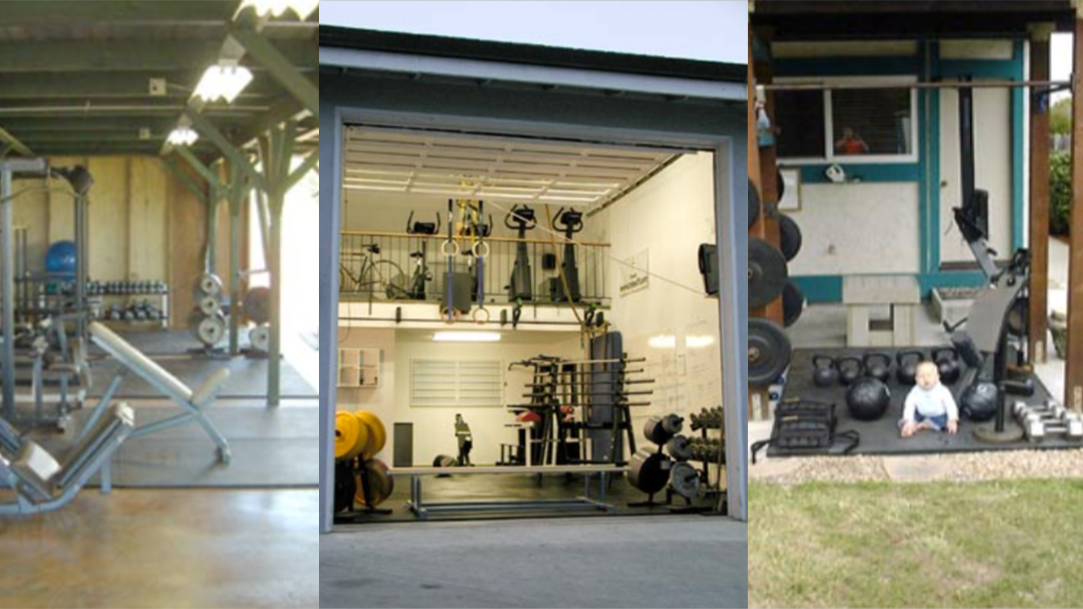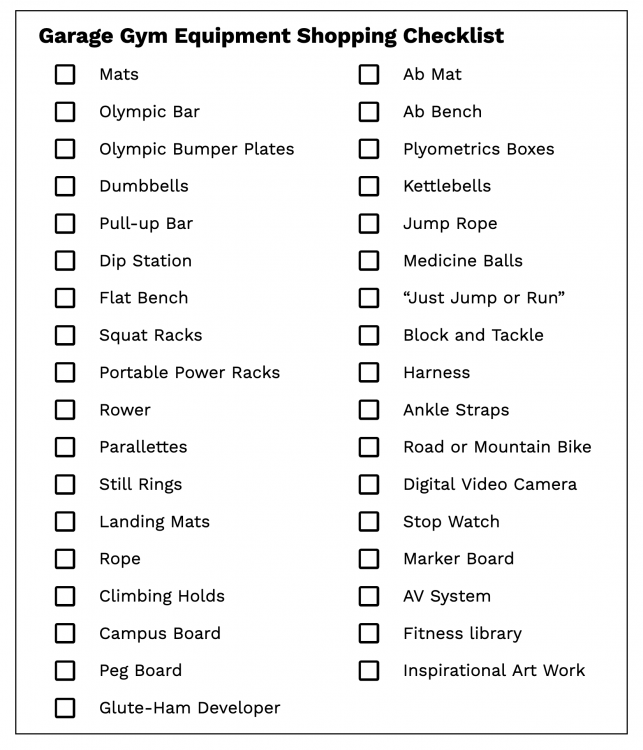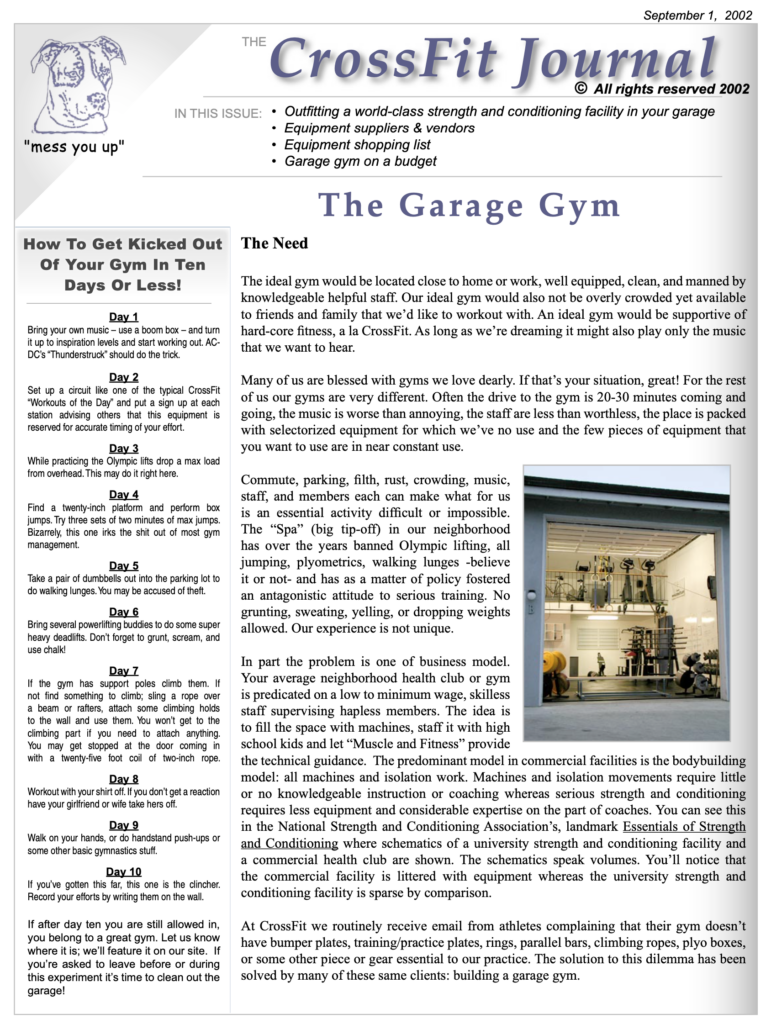The Need
The ideal gym would be located close to home or work, well equipped, clean, and manned by knowledgeable helpful staff. Our ideal gym would also not be overly crowded yet available to friends and family that we’d like to workout with. An ideal gym would be supportive of hard-core fitness, a la CrossFit. As long as we’re dreaming it might also play only the music that we want to hear.
Many of us are blessed with gyms we love dearly. If that’s your situation, great! For the rest of us our gyms are very different. Often the drive to the gym is 20-30 minutes coming and going, the music is worse than annoying, the staff are less than worthless, the place is packed with selectorized equipment for which we’ve no use and the few pieces of equipment that you want to use are in near constant use.
Commute, parking, filth, rust, crowding, music, staff, and members each can make what for us is an essential activity difficult or impossible. The “Spa” (big tip-off) in our neighborhood has over the years banned Olympic lifting, all jumping, plyometrics, walking lunges -believe it or not- and has as a matter of policy fostered an antagonistic attitude to serious training. No grunting, sweating, yelling, or dropping weights allowed. Our experience is not unique.
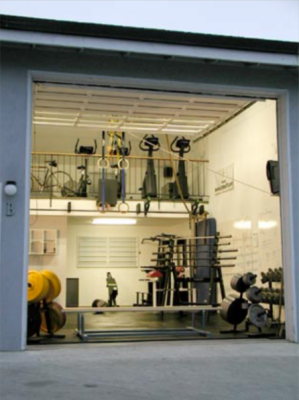
In part the problem is one of business model. Your average neighborhood health club or gym is predicated on a low to minimum wage, skilless staff supervising hapless members. The idea is to fill the space with machines, staff it with high school kids and let “Muscle and Fitness” provide the technical guidance. The predominant model in commercial facilities is the bodybuilding model: all machines and isolation work. Machines and isolation movements require little or no knowledgeable instruction or coaching whereas serious strength and conditioning requires less equipment and considerable expertise on the part of coaches. You can see this in the National Strength and Conditioning Association’s, landmark Essentials of Strength and Conditioning where schematics of a university strength and conditioning facility and a commercial health club are shown. The schematics speak volumes. You’ll notice that the commercial facility is littered with equipment whereas the university strength and conditioning facility is sparse by comparison.
At CrossFit we routinely receive email from athletes complaining that their gym doesn’t have bumper plates, training/practice plates, rings, parallel bars, climbing ropes, plyo boxes, or some other piece or gear essential to our practice. The solution to this dilemma has been solved by many of these same clients: building a garage gym.
Now, when you look at the sea of worthless machines that makes up a commercial facility, the idea of developing a garage gym may seem daunting. Just remember, we’re building a strength and conditioning gym, not a bodybuilding gym. We wouldn’t keep 99% of the equipment at your Gold’s gym if it were given to us.
The Cure
Here’s the great news. You can build, rather inexpensively, a world-class strength and conditioning facility in your garage! At the CrossFit facility in Santa Cruz, California, we’ve picked up every piece of equipment critical to forging world-class athleticism, and many of our clients have the same stuff at home. Our facility is in fact little more than an oversized high ceiling garage. There’s no piece of equipment that we need but don’t have, not one. The same is true of our clients who’ve built their own facilities. They’ve got exactly what they need.
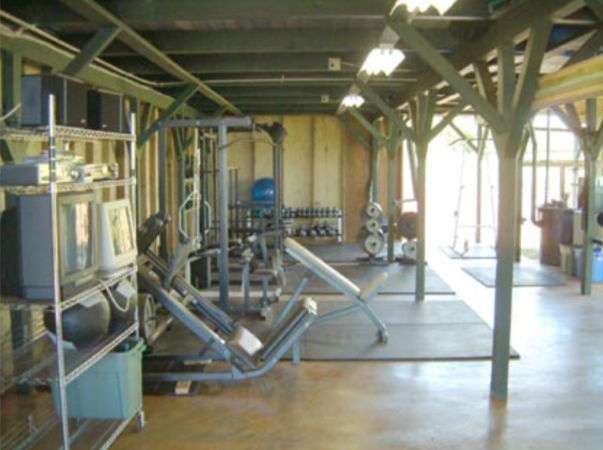
The garage gym tradition is revered and respected. The number of athletes training in garages, barns, and abandoned buildings is legion. Many of these are world dominant in their sport. Some go this route because no other resources are available, but most have chosen the garage-gym realizing it best provides for their needs. The lifting, throwing, jumping, and climbing essential to responsible programming will find no welcome home for you and your friends at 24-Hour Nautilus.
Your garage is begging to become a gym. There is within your garage more than enough space to develop a gym that will rival just about any commercial facility. Yeah, we know, your car and 15 years worth of accumulated junk make current use of that space. What we’re talking about here is repurposing your garage from junkyard and auto shelter to a first-rate strength and conditioning facility. Pull the car into the driveway. Cover it if you must. Have a garage sale for the junk of value. You can erect a Rubbermaid storage shed in the back yard for all of your gardening equipment, tools, and other things you want to keep. The rest throw away! If your garage is full of “stuff” that you don’t want to keep the easiest solution is to rent a disposal bin. The rental yard will drop the bin off and come back for it and dispose of the contents when you’re done. It’s easy!
How To Get Kicked Out Of Your Gym In Ten Days Or Less!
Day 1
Bring your own music – use a boom box – and turn it up to inspiration levels and start working out. AC/DC’s “Thunderstruck” should do the trick.
Day 2
Set up a circuit like one of the typical CrossFit “Workouts of the Day” and put a sign up at each station advising others that this equipment is reserved for accurate timing of your effort.
Day 3
While practicing the Olympic lifts drop a max load from overhead. This may do it right here.
Day 4
Find a twenty-inch platform and perform box jumps. Try three sets of two minutes of max jumps. Bizarrely, this one irks the shit out of most gym management.
Day 5
Take a pair of dumbbells out into the parking lot to do walking lunges. You may be accused of theft.
Day 6
Bring several powerlifting buddies to do some super heavy deadlifts. Don’t forget to grunt, scream, and use chalk!
Day 7
If the gym has support poles climb them. If not find something to climb; sling a rope over a beam or rafters, attach some climbing holds to the wall and use them. You won’t get to the climbing part if you need to attach anything. You may get stopped at the door coming in with a twenty-five foot coil of two-inch rope.
Day 8
Workout with your shirt off. If you don’t get a reaction have your girlfriend or wife take hers off.
Day 9
Walk on your hands, or do handstand push-ups or some other basic gymnastics stuff.
Day 10
If you’ve gotten this far, this one is the clincher. Record your efforts by writing them on the wall. If after day ten you are still allowed in, you belong to a great gym. Let us know where it is; we’ll feature it on our site. If you’re asked to leave before or during this experiment it’s time to clean out the garage!
Starting from the Ground Up: Matting
Once the garage is cleared and cleaned the next obvious step is to mat it. Matting is expensive but adds so much to comfort and safety that they are a must. Install in installments, one mat at a time if you need to.
Avoid buying your mats from fitness vendors. You can find 4’X6’X 3⁄4 “ rubber mats exactly like the ones sold by Bigger Faster Stronger (one of our favorite vendors) at your local horse feed and tack store. The same mats are sold by feed and tack stores as horse stall mats. Even if you have to rent a truck and drive two hours out of Manhattan to find a feed and tack store you’ll save a bundle by not paying for shipping. The mats are 50-60 pounds apiece and the shipping is outrageous. You’ll need one mat for each 24 square feet of garage.
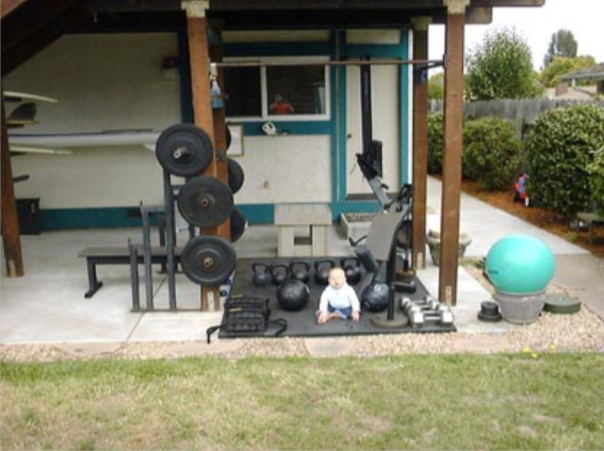
We recommend that you draw your garage to scale on a paper and you’ll see how many mats you can lay without cutting and how many you have to cut. Cutting the mats is not easy!! In fact, it’s really, really hard. The best approach is to make a template out of brown shopping bag that fits the space for which you want to cut a mat. Lay the brown bag out on the mat to be cut and trace with white chalk the line you want to cut. Cutting 3⁄4” rubber matting is best achieved with a utility knife. Use a four-foot steel or aluminum rule to draw your lines and to make the first pass with the knife. It will help to draw your lines approximately 1⁄4” past what you’ve measured. Due to the compressibility of the mats this allows for really tight, nice, seams.
Let only about a 1⁄2” of blade out and from your belly with arms out straight overhead draw the knife towards you along the chalked line. Each cut will only be about 18 inches long and about 1⁄4 inch deep. So, it will take three passes to get through. Don’t cut over the cement or on any surface you don’t want to ruin. We recommend a sheet of plywood under the mats you are cutting.
This is one chore where a friend is almost essential. You’ll want help loading and unloading the mats and measuring, cutting, and fitting them. They are only 50 pounds or so but couldn’t be more awkward. They feel like they weigh 300 pounds a piece by the end of the day. This chore requires patience.
Don’t even think about using a skill saw or other power saw. The resulting fire and smoke will take hours to clear and that’s from a six inch cut. We’ve seen first timers make near perfect cuts around poles and corners using just a utility knife. Careful work and positioning of the mats will minimize seams and gaps. We use a twenty-five pound plate to slide into the mat’s edges to cram them together shrinking gaps before laying the next mat. This is the hardest part of the garage gym.
Note about suppliers
Many equipment supply companies have come and gone since this article was written in 2002. Some of the references and links to specific companies have been edited, replaced, or deleted from this version.
Spawning from the explosive demand for CrossFit equipment, Rogue Fitness, Again Faster, and a few other companies now stock many of the items mentioned here.
Bare Minimum: Weights & Pull-up Bar
You want to get an Olympic weight set. These have the rotating sleeves and accept plates with the 2” holes. You’ll never regret buying a quality bar. It will set you back several hundred dollars but provide a lifetime of service. Bigger Faster Stronger and IronMind are our favorite vendors and Ivanko, Eleiko, and York are our favorite manufacturers. You may want to think about “Aluma-lite” and “Ultralite” bars if your gym is going to be used by women, seniors, or children. These bars weigh 15 and 30 pounds respectively. We have and use both. A standard Olympic Bar is 45 pounds. If you are going to be working out with buddies you are going to want two Olympic bars. As far as plates go we highly recommend that you go with solid rubber composition plates. These plates are safer and quieter than steel and even regular bumper plates. If we were outfitting our facility again we’d go all rubber and almost no steel. The only steel we need is 2 1⁄2 pound plates. The rubber composition plates come in 25-20-15-and 10 kg weights. The rubber plates cost more but the noise reduction alone makes them worth the money.
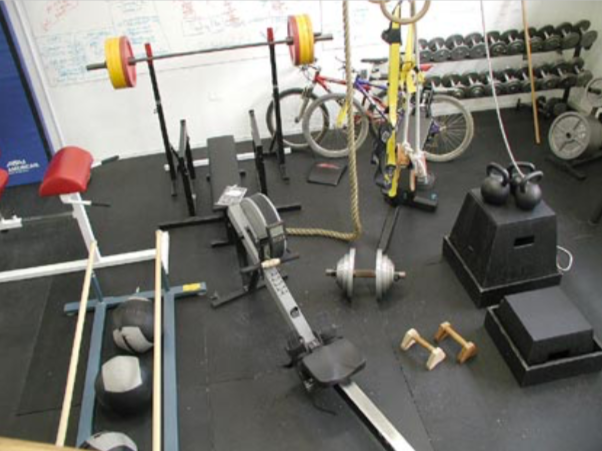
You’ll want an Olympic Bar and Olympic Bumper Plate holder. It’s annoying and unsafe leaving this equipment on the floor. The bar holders that hold the bars on end take up little space. If your plates are all full-sized bumper or rubber composition plates make sure your rack is designed to hold Olympic bumper plates. These plates are all 18 inches in diameter. We’ve made this mistake in ordering racks.
Dumbbells are not absolutely essential, but we wouldn’t be happy without them. Our favorite is the Durabell Dumbbell made by Hampton and carried by York Barbell Company. They are super durable, rubber coated, and won’t come apart and drop plates in your mouth. Best of all they store in vertical racks that take up little room. This is a great dumbbell and racking system at a great price. We paid a lot more for a lot less, unfortunately. Where budgets and space are tight you want to consider IronMind’s “Olympic-Style Husky Handle Dumbbell Bars.” These Dumbbells have to be seen and handled to be believed. They take Olympic plates and are thick handled (2 inches). You’ll never outgrow these monsters. People’s jaws drop when they see them.
You need a place to perform pull-ups and dips. The temptation is to go with one of the many freestanding pull-up and dip towers. They are cheap and adequate to the task but flimsy and take up valuable floor space. In our garage gym we place a premium on floor space. Power Systems makes a wall mounted pull-up bar and dip bar. We’ve had trouble with equipment coming damaged from Power Systems but these items are very sturdy and ultimately Power Systems made good on the damage. You can also have wall mounted pull-up and dip bars made by a local welder.
We had a local welder build CrossFit a pull-up bar and mounting brackets that is twenty feet long. We also commissioned him to design and fabricate a thick handled (2” diameter) revolving pullup bar. This monster will take someone with thirty pull-ups and bust them down to five reps. The load on the hands and forearms is amazing.
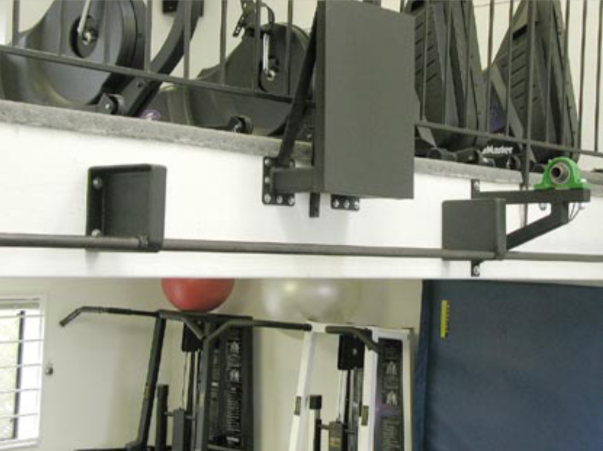
There’s another angle to pull-ups and dips. We have in our facility two Starmaster Gravitrons (no longer produced). They have proven indispensable to developing pull-ups and dips in individuals not strong enough for either the pull-up or the dip. The pull-up and dip are unsurpassed in developing functional upper body strength and are formidable obstacles for most women and seniors. For them the Gravitron is indispensable. If you can’t do a pull-ups or dip you need a Gravitron. If you already have pull-ups and dips the Gravitron is still a great tool to work additional reps when spent or for warm-up. The newer Gravitron allows for lowering of the carriage and provides a station for unassisted pull-up and dips. Though far from cheap they have been indispensable to CrossFit’s practice. Some of our friends have found remanufactured Gravitrons for nearly half of the new price. Search the Internet for used Gravitrons.
If you only had a bar and a place to do pull-ups you could do an acceptable variant of the CrossFit Program. With this minimal amount of equipment you could do deadlifts, squats, push-press, push-ups, cleans, and pull-ups. In fact the minimalist/low-budget approach to our program is to do deadlifts and Tabata Squats on day one, push-press and push-ups day two, and cleans and pullups day three and rest day four. Repeat. In minimalist/low-budget mode we derive our metabolic conditioning from running and jumping rope. You could get amazing results on this regimen. Our desire here, though, is to lay plans for a world-class strength and conditioning facility in your home. Let’s proceed with the rest of our design.
The Benches and Racks
Now we want to get some “furniture”. You will need to have a flat bench, squat racks, and “portable power racks”. IronMind is the first choice for these critical pieces.
Squat racks are the next most important piece of equipment after your Olympic bar and pull-up bar. The IronMind squat racks are called “Vulcan Racks.” They weigh only 50 pounds yet can support 1,500 safely. They are adjustable from 37.5 – 64” making them ideal for squatting and pressing, bench or standing. The more we use these racks the more we like them. They are used at the U.S. Olympic Training Center as well as at CrossFit. IronMind also makes dipping handles that transform the Vulcan Racks into a reasonably stable dipping platform.
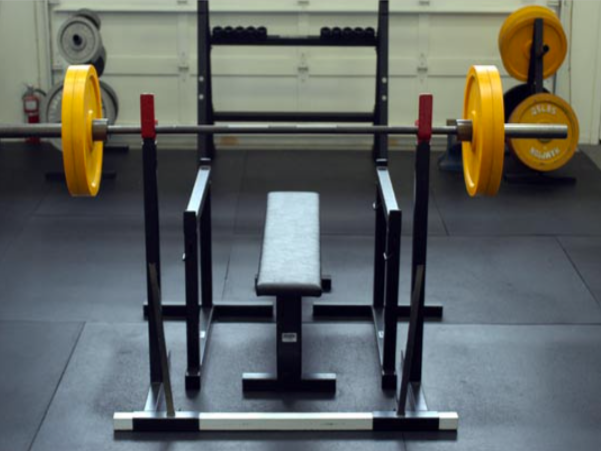
The IronMind flat bench (“Five Star Flat Bench”) is built to last forever. This all steel bench is the perfect bench for bench press though we’ve found it handy for dozens of other uses from step-ups to reaching our pull-up bar. We’ve seen cheaper but not stronger benches. IronMind’s “Pillars of Power” are in a sense portable power racks. These bombproof racks – they will support 4,000 pounds – are a perfect tool for self-spotting bench press and squats as well as an excellent loading platform for numerous exercises. Spotting is always a dilemma when working out alone. The Pillars of Power are actually a better spotter than a workout partner for the bench press and squat.
The beauty of the Vulcan Racks, Five Star Flat Bench, and Pillars of Power is that they are professional grade equipment in use by hard-core lifters world wide, can be tucked away to fit in the smallest of spaces, and are perfectly portable. You are not compromising with this stuff. Programs with multi-million dollar budgets and acres of space are using this same gear. We’re talking about some of the best training equipment available at any price!
Our Favorite Piece of “Cardio” Equipment
A jump rope, good bike, running shoes, and the Concept II Rower. That’s the CrossFit cardio equipment list. Let’s take a look at the rower.
Our favorite piece of equipment for metabolic conditioning (“cardio”) is the Concept II Rower. The effect of rowing has to be experienced to be believed. Many of our world champion fighters are terrified of the rower! Often a good thousand-meter effort leaves an impact on the body that lasts for days. The claim of a complete or whole body exercise is often made and seldom true. Rowing is as complete as any single exercise can be. As for the Concept II Rower itself, they are cheap ($1,000) and virtually indestructible and essentially maintenance free. We’ve seen Concept II Rowers that have been in daily commercial use for years and years without any maintenance.
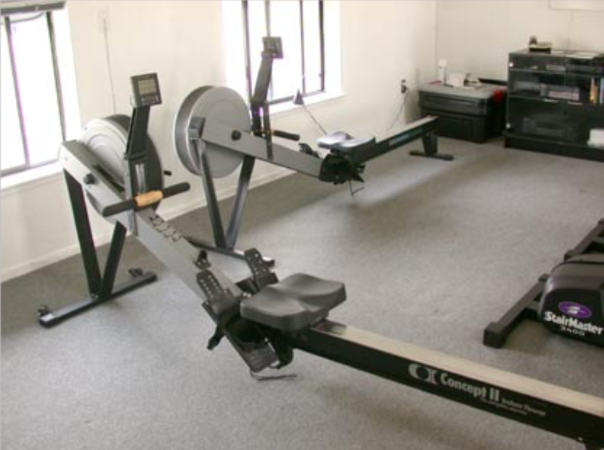
Concept II has an outstanding website where rowers post their times at varying distances grouped by age, gender, and weight. The pool of athletes is deep enough that the posted times legitimately reflect a world ranking. This is possible because the Concept II Rower (C2) is a common and valuable tool of internationally competitive rowers. Concept II has turned their product into an international sport. We don’t know of any other product that can make a similar claim.
The console on the C2 is our favorite on any “cardio” equipment. On this rower we can easily program any interval pattern we want like the Tabata interval (20 seconds of work followed by 10 seconds of rest, repeated 8 times). The C2 console allows us to row for time or distance and gives projected times and distances making targeted efforts easier. It’s unbelievable to us that this flexibility is unique to this equipment.
The Concept II Rower stores on end and in this position takes up less space than most other common pieces of “cardio” equipment. Only running and jumping rope require equipment (shoes & rope) that stow away as compactly as this rower.
But, I’m Broke!
If your budget is seriously limited here are some ideas:
- Start with an Olympic bar and some rubber composition plates and a pull-up bar. That’s enough to get started. You can find retailers in your area with what you need so that you can avoid shipping costs. They’re substantial!
- Make what you can. If you’ve the skill or know someone with the talents much of our equipment can be fabricated for less.
- Shop around. Buy used. Gym equipment goes for pennies on the dollar at garage sales and in the classified section of your local paper. Make a habit of checking in with used sporting good stores, the classifieds, and the internet for used equipment.
- You can mat your garage one mat at a time.
- Allocate a monthly budget for the project and be patient.
- Ultimately, be resourceful. If you want a gym nothing can stop you.
Gymnastics and Climbing Equipment
Because gymnasts have an extraordinary strength to weight ratio, unrivaled torso/upper body strength, and can express this strength in a multitude of planes, CrossFit makes regular use of skills and drills that develop this capacity. Other than the pull-up bar and dipping platform already mentioned we have parallettes (short parallel bars) and still rings.
Our parallettes came from AAI (and are marketed as “low parallel bars”. AAI’s “low parallel bars” are adjustable from 14-20” wide, stand 16” high and are 8’ long. While unwieldy and somewhat large this is one piece of equipment you’ll never outgrow. Presses to handstand, handstands, push-ups, pirouettes, L-holds, V-holds, … the list of exercises that can be learned on these is extensive. This is an ideal place to develop upper body strength, abdominal strength, agility, balance, coordination, and accuracy.
Space and budget may not allow for the commercial bars, so here are plans for homemade parallettes. Made from PVC these bars will allow for much of what you can do on the bigger set.
We strung a pair of still rings from our vaulted ceiling. You may not have the great luxury of a 15-20 foot ceiling. That doesn’t mean you can’t take advantage of the incomparable upper body strength that can be developed on the rings.
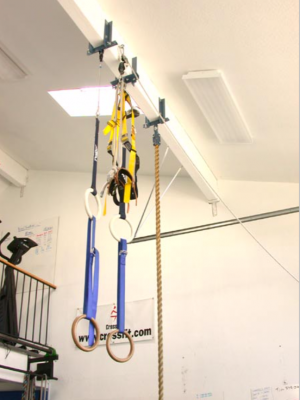
We’ve seen rings hung over a wall or beam mounted pull-up bar allowing for muscle-ups (pulling yourself from a hang below the rings to a support above and dipping to full extension) and dips. The difference in difficulty between bar dips and ring dips is a source of unending entertainment. That’s all we’ll say about that.
As for the muscle-up, you just think you’ve got good upper body strength until you’ve actually done one. The muscle-up combines the world’s nastiest pull-up with the hardest dip. The muscle-up is a functional movement that enables you, once you’ve mastered it, to surmount any object on which you can get a finger hold. This is potentially a life saving skill. We’ll cover the muscle-up in great detail in a later issue, but let it suffice to say for now that the muscle-up is an indispensable tool for developing stupefying upper body strength. Learn the muscle-up; you can’t without rings. Finally, the wooden rings and strap assembly hung over your pull-up bar is the ideal solution as to where to do dips.
We also use landing mats from AAI for stretching and to cushion a possible fall from the parallel bars, rings, or rope climb. Our favorite mat is 3.5’ X 6’ X 4”.
Rope Climb is an extraordinary exercise yet requires a tall ceiling. Some of our friends have strung a rope in a tree in their yard. If you had a garage with exposed rafters you could string a shorter rope and start from seated and make multiple trips up and down for great effect. Our rope came from AAI, but it was expensive. AAI’s ropes are absolutely beautiful, come in custom lengths and are booted or braided/knotted at the end to prevent unraveling. AAI Climbing Ropes also come with mounting hardware. They have several styles including one with braided knots every 12” to assist the beginner.
You won’t find a better rope than AAI’s, but you can put together a Climbing Rope at a fraction of the cost. One of our friends bought a length of 1 1⁄2 “ twisted manila rope, ran an eye bolt through a beam and passed the rope through the eye and tied a knot in the end to keep it from coming through. If monitored regularly for wear and fraying this is perfectly safe. The floor end needs to be knotted or “whipped” to keep from unraveling. This is not a pretty solution, but there’s no compromise in function with this approach.
The Climbing Rope may or may not be an option in your gym, but there are several other climbing options that are possible in any space. Climbing Holds, Campus Boards, and Peg Boards are wickedly effective, functional, and fun. We’ve limited experience with this stuff, but it is our next frontier.
We’ve plans to fill our walls with climbing holds. This is cheap, beautiful, takes no usable space and is functional. You could put hundreds of these up in your garage. Search Google for “Climbing Holds.” There are several we are considering:
They mount to plywood and the plywood mounts to your walls. The vendors will supply all the hardware and instructions for installation. This is a must for a garage gym in our opinion.
Campus Boarding is great exercise. Metolius explains the history and details of campus boarding and gives plans for constructing and installing a campus board and sells the equipment. We don’t know of a better site or source for campus boarding. CrossFit plans to install a campus board within the next few months. Again, great functional exercise, doesn’t take from otherwise usable space, and FUN!
Peg Boards can be used to develop great back and arm strength. Again, we’ve plans to install Peg Boards on our walls soon. This is our favorite alternative to the Climbing Rope. This is, perhaps, a limited option with a low ceiling.
As a note, weight training generally lacks in pulling movements compared to pushing movements. This is why we place such an emphasis on gymnastics and climbing in our program. The Climbing Rope, Campus Board, Climbing Holds, and Peg Board all give great work emphasizing the back and arms as well as the hands and forearms. These apparatus are invaluable to rounding out your program.
Trunk Development Equipment
CrossFit’s trunk work comes primarily from hip/back extensions and sit-ups performed on a Glute-Ham Developer and abdominal work done on our “Ab Bench” and “Ab Mat.” The rest of our trunk work is calisthenics movements that, of course, require no equipment.
Our Glute-Ham Developer (GHD) came from Power Systems. It came late, broken, poorly welded and to this day wobbles a little like a bad table that needs a match book under one of the legs. Though a mess, we had it fixed, and Power Systems gave us a refund large enough to forgive the shoddy workmanship, and most of the frustration. Many of our friends have gone with the Bigger Faster Stronger GHD. It’s just “O.K.” We’re not convinced we’ve seen the best of the GHD’s on the market.
The science behind both the “ab mat” and the “ab bench” are perfectly brilliant. Koch, Blom, and Jacob are responsible for the research and understanding behind these products. You can read about and order from ab mat. This is one of the best $40 investments you can make.
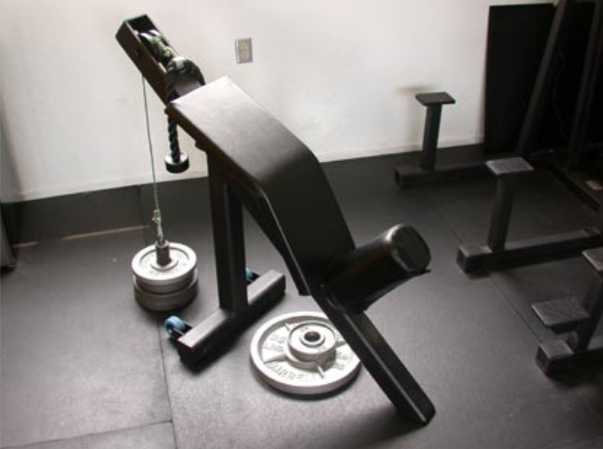
The “ab bench” incorporates the same science. We put our local welder, Nick, on the task got a much, much better ab-bench than those available online, with an improved design. Nick’s version of the ab-bench is something we are proud of.
Miscellaneous Basics
Plyometrics boxes are a simple and wickedly effective tool for both explosive/power training and metabolic conditioning. Timed box jumping is high intensity functional exercise and a regular feature in CrossFit’s Workout of the Day. We have a full set of plyometrics boxes from BFS but use the 20” box almost exclusively. We use the 10” box for “box squats” both weighted and free. We recommend getting the 20” box, its booster, and the 10” box. This gives you an excellent jumping box at three heights (the booster provides both a two and four inch boost depending on it’s orientation) and a box for box squats.
The two-arm Kettlebell swing is a great exercise and for that we purchased Pavel Tsatsouline’s Kettlebell set from Dragon Door Enterprises. The set includes a 36, 53, and 72- pound Kettlebell. With the exception of the two-armed swing most of the Kettlebell exercises have been more novelty than productive. Additionally, most of the exercises featured on Pavel’s videotape can be equally or better facilitated with dumbbells than the Kettlebell. Still, we recommend getting a set. The competitions have been a blast. We’ll frequently pit two athletes against one another to see who can keep swinging the big one overhead for the best time.
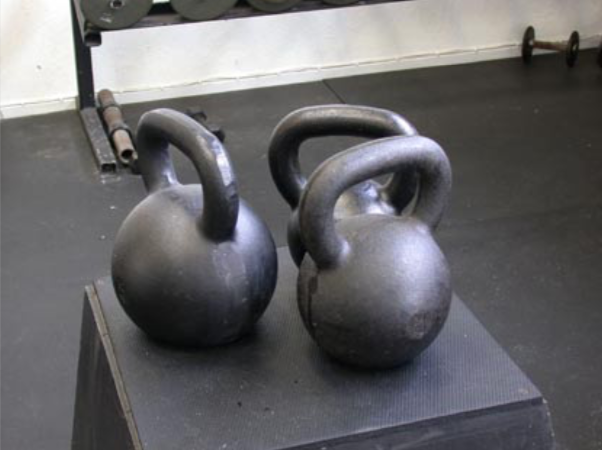
It may seem trite to cover, but there’s something to jump ropes. There are two general trends in the design of jumping ropes: heavy and fast. After years of experimentation with both, we’ve come down squarely on the side of the fast rope.
We have in our facility several Dynamax Medicine Balls. The Dynamax ball is a soft, low bounce ball. Dynamax’s claims about the advantages of a less lively ball are proven the instant the ball bounces off your face, and it’s a certainty that given enough exposure this is going to happen. The manual that comes with the Dynamax ball is one of the best publications accompanying any fitness product.
We have two unique applications for medicine ball training. The first is “wall ball.” Wall ball is essentially a deep front squat-pushpress/throw with a rapid recycle time. Nick made a steel backboard for this drill. In addition to the “wall-ball” drill we use the medicine ball to teach the power clean and squat clean. This has been an extraordinarily effective drill to that end.
Miscellaneous Luxury Items
This brings us to our last piece of strength and conditioning equipment, Probotics “Just Jump or Run“. The “Just Jump or Run” is an electronic device that tests vertical jump, reaction time, sprint time, and anaerobic fade. We had a lot of fun with this for a while, but we don’t use it much anymore, and I’m not sure if it was worth the $500 we paid for it.
As aids to instruction we’ve some specialized equipment that while being very useful for an instructional environment may have limited applicability for a home gym. Our facility has a 15-foot ceiling from which we’ve attached a block and tackle assembly from Harken with a 4:1 purchase. We use this with both heavy-duty leather padded ankle straps and a “Delta No-Tangle Harness Vest Style” from Sala. The ankle straps (from Power Systems) we use to spot and assist handstand push-ups and presses on the rings and parallel bars and the harness we use to assist the muscle-up. If you’ve the ceiling height, budget, and commitment these items are of enormous benefit.
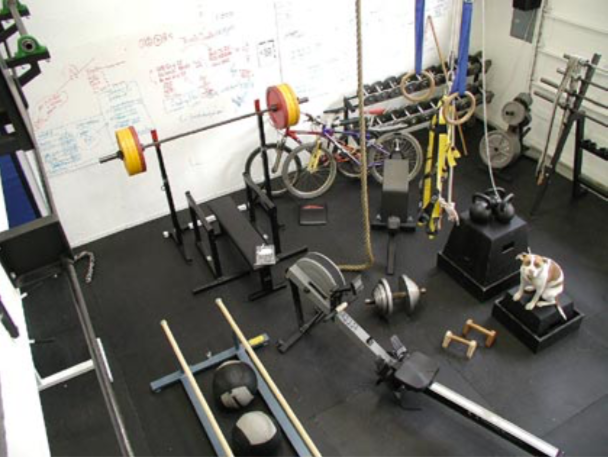
CrossFit also has a Sony digital video camera. Whether in a professional coaching environment or working out by yourself in the garage you can’t see what it is that you are doing right or wrong without video. Eventually in your training this becomes more necessity than luxury especially for the Olympic lifts and gymnastics movements. It’s cool.
You’ll need a stopwatch for your workouts. Our favorite is the Seiko S052 Interval Timing Stopwatch. This watch will time intervals of any work time, rest time, and total interval count you choose. This is a gem of a watch for the Tabata Interval. This great watch chimes a countdown for the work interval and the rest interval distinct from the end and beginning of the work and rest interval so that it can be used hands free and without looking at the watch to time your interval training efforts. Once you’ve used this watch other timing methods seem difficult.
We’ll mention here in the name of completeness that we also have at CrossFit two StairMaster Stairclimbers and two StairMaster stationary bikes. They’re fun, good diversion, but not critical.
Finishing
We recommend that you finish your garage in 3⁄4” plywood. Lag bolted securely to the studs the plywood becomes the perfect surface for mounting anything you want or need. If you finish most of the wall space with plywood you can cover your walls with climbing holds and have perfect flexibility for mounting your pull-up bar, dip bars, campus board, peg board, etc. The look is also appealing and shows your pride in what you’ve built.
We’ve mounted sheets of marker boards on the CrossFit gym walls for use with dry erase markers. You can buy 4’ X 8’ sheets of marker board for about $15 per sheet from most lumber yards. We record achievements for various efforts on these boards. This can provide a very public display of your accomplishments and in turn becomes a wonderful source of motivation. We didn’t know when we affixed these boards just how important they’d become. Now we couldn’t be without them. Neither should you. Take our word for it.
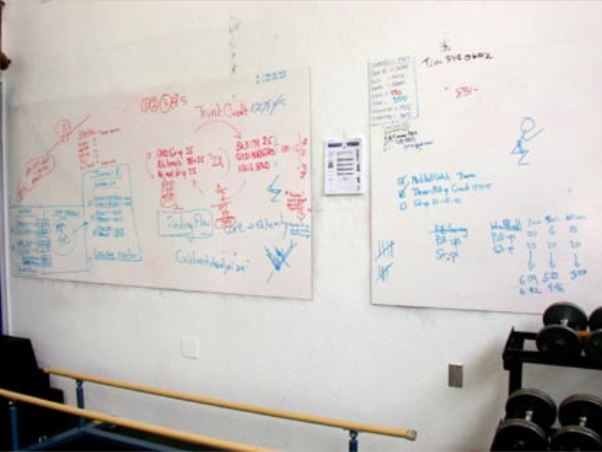
We have a wall mounted monitor, satellite TV and music, and a full rack of audio-visual gear at CrossFit. Whether you’re blasting your favorite tunes, keeping an eye on the stock ticker before leaving for work, or running IronMind’s Bulgarian Training Hall Olympic Lifting Videotape as background motivation, the total effect of an AV system is fantastic. We make extensive use of our system for entertainment, motivation, and instruction.
Every garage gym should have a library and there’s no better way to seed your fitness library (other than with the CrossFit Journal, of course) than with Milo. Milo is billed as “a journal for serious strength athletes.” Milo is incredible. Randall Strossen, the owner of IronMind will live forever in fitness lore for publishing Milo. Milo is honest, gritty, homegrown, and one of a very few legitimate journals in the fitness world. We wouldn’t trade a single issue of Milo for all the popular fitness magazines in the world. You’ll also want to get catalogs from the vendors we’ve mentioned here for your shelf. They are collectively a fine source of motivation and ideas. In a future edition we will make recommendations for material to flesh out your fitness library.
The final touch (in reality you’ll never finish, which is cool) is artwork. Throw your favorite sport or athlete into Google along with the words “poster” and you’ll be likely to find a poster that will be both entertaining and inspirational. If you don’t know where to start just put “sport posters” into google and start surfing. You’ll find more than you’ve time to look at.
“Look What You’ve Done”
Don’t let the fact that your garage is only 400 square feet or so deter you. CrossFit’s gym is approximately 1,200 square feet and we routinely operate with three trainers and three to six athletes at one time. The typical garage is perfectly sized for an elite strength and conditioning program servicing a family or individual and friends. In truth, some of our friends have built their gyms in less than 200 square feet!
It needs to be explained that your home gym doesn’t aspire to be as good or complete as a commercial facility; your gym has the potential to be much, much, better. State-of-the-art strength and conditioning technology, like CrossFit, is more readily facilitated in a well-appointed garage than in a Gold’s Gym, World’s Gym, Family Fitness Center, 24-Hour Nautilus, or Balley’s. These chains and gyms like them cannot support elite professional programming; you can.
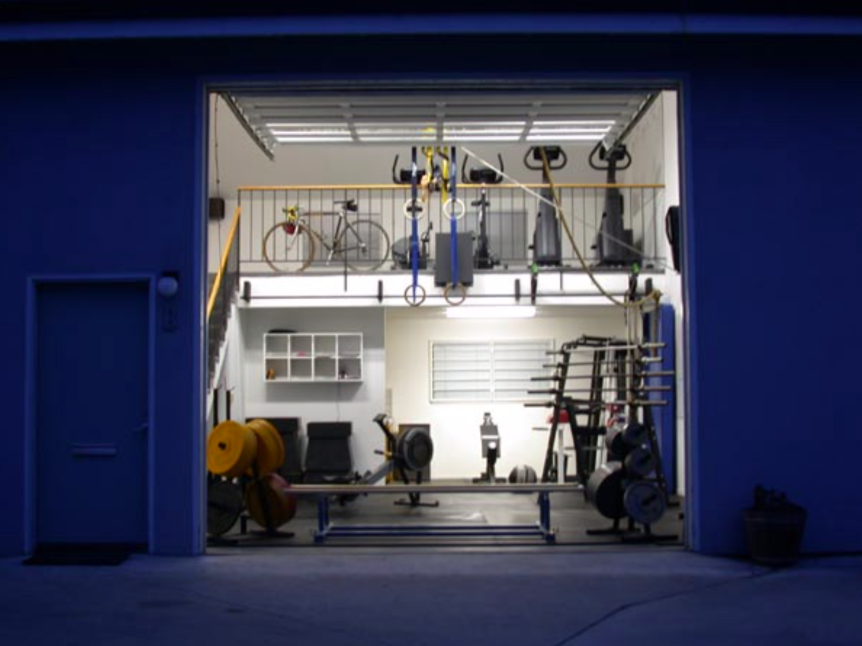
It bears repeating: the commercial model is predicated on simple movements requiring little or no coaching and inexperienced low paid staff. This is the only reason bodybuilding practices permeate these facilities. Where lives and livelihoods depend on fitness this model is woefully lacking. The professional strength and conditioning facility requires different equipment, cheaper and less equipment, but professional staff and instruction. CrossFit, through the CrossFit Journal will provide that expertise. We know it can be done; we’ve done if for thousands through our website.
CrossFit endeavors to lead a revolution in fitness training, a radical departure from the ineffectual, non-functional prevailing bodybuilding model of the commercial gyms and towards the professional strength and conditioning model of the university, pro sports franchise, and military. Your needs, regardless of your current fitness, differ from the professional or elite athlete’s by degree not kind. We’re waging this revolution in your home. That’s the only place it can be won.
If cost is an objection you may consider reevaluating your priorities. If your living room, bedrooms, kitchen, or dining room are well appointed there’s no substance to the argument that you cannot afford your own gym, unless your health and fitness are lesser priorities than your leisure and entertainment.
The satisfaction derived from building your own gym and sharing it with your friends is sure to surprise you. Those that have gone this route find that with each modification or additional piece of equipment their enjoyment and pride increase.
This article, by BSI’s co-founder, was originally published in The CrossFit Journal. While Greg Glassman no longer owns CrossFit Inc., his writings and ideas revolutionized the world of fitness, and are reproduced here.
Coach Glassman named his training methodology ‘CrossFit,’ which became a trademarked term owned by CrossFit Inc. In order to preserve his writings in their original form, references to ‘CrossFit’ remain in this article.
Greg Glassman founded CrossFit, a fitness revolution. Under Glassman’s leadership there were around 4 million CrossFitters, 300,000 CrossFit coaches and 15,000 physical locations, known as affiliates, where his prescribed methodology: constantly varied functional movements executed at high intensity, were practiced daily. CrossFit became known as the solution to the world’s greatest problem, chronic illness.
In 2002, he became the first person in exercise physiology to apply a scientific definition to the word fitness. As the son of an aerospace engineer, Glassman learned the principles of science at a young age. Through observations, experimentation, testing, and retesting, Glassman created a program that brought unprecedented results to his clients. He shared his methodology with the world through The CrossFit Journal and in-person seminars. Harvard Business School proclaimed that CrossFit was the world’s fastest growing business.
The business, which challenged conventional business models and financially upset the health and wellness industry, brought plenty of negative attention to Glassman and CrossFit. The company’s low carbohydrate nutrition prescription threatened the sugar industry and led to a series of lawsuits after a peer-reviewed journal falsified data claiming Glassman’s methodology caused injuries. A federal judge called it the biggest case of scientific misconduct and fraud she’d seen in all her years on the bench. After this experience Glassman developed a deep interest in the corruption of modern science for private interests. He launched CrossFit Health which mobilized 20,000 doctors who knew from their experiences with CrossFit that Glassman’s methodology prevented and cured chronic diseases. Glassman networked the doctors, exposed them to researchers in a variety of fields and encouraged them to work together and further support efforts to expose the problems in medicine and work together on preventative measures.
In 2020, Greg sold CrossFit and focused his attention on the broader issues in modern science. He’d learned from his experience in fitness that areas of study without definitions, without ways of measuring and replicating results are ripe for corruption and manipulation.
The Broken Science Initiative, aims to expose and equip anyone interested with the tools to protect themself from the ills of modern medicine and broken science at-large.
Support the Broken Science Initiative.
Subscribe today →
recent posts
Medical Society Webinar with David Wiss
